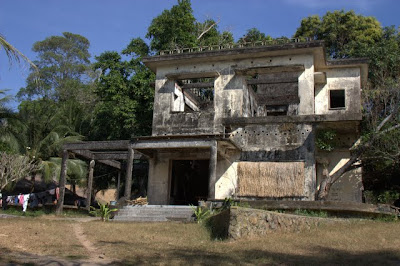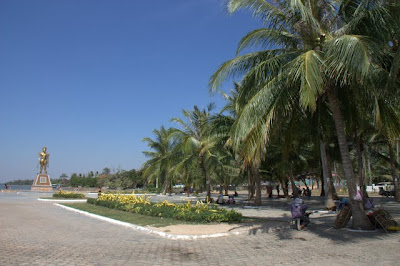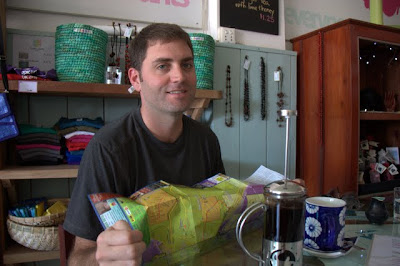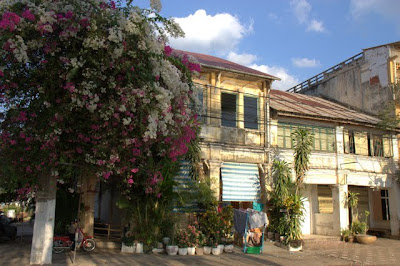An Afternoon by the Sea in Kep
I was going to lump Kep in with Kampot, but we adored Kep just as much so I thought it rightfully deserved its own post. Kep is only 15 miles away from Kampot and unlike Kampot, actually sits right on the sea. We set off under sunny skies on our favorite Asian transport – our own two wheels – and headed down a paved road past cows, green fields, and mountains. We knew we arrived when we could smell the sea in the air. After a scoot around town and some time lounging on the seaside promenade watching the locals swim in the sea, we concluded that it doesn’t get much sleepier than Kep. It’s the type of place that makes you want to sit still, to slow time down and linger.
So we did. Kep has a collection of seaside cafes all serving one thing: crabs caught by local fisherwomen in the waters right out front. We found one with cushy seats by the water and plopped ourselves down for a leisurely lunch. While waiting for our crabs, we watched women in floppy hats wade out into the waters in front of us and trap more of the day’s catch. Before we left, Sean never ate seafood. But it is hard to resist seafood as fresh as this, and somewhere between the red snapper in Essaouira and the tiger prawns in Fort Cochin, he’s become a convert. When the crabs arrive, we devour them. They’re fried whole with fresh green peppercorns from Kampot, and dressed with a black Kampot pepper and lime marinade. I think it goes without saying that they are sublime.
There was talk of staying for sunset and having more crabs for dinner. There was more talk of spending the next night in Kep. In the end, we did neither and left Kep behind in its sleepy solitude.
I don’t think Kep will stay this way. As Cambodia distances itself from its turbulent past, somebody’s going to want to come in and make money from Kep’s seaside location. As it stands now, though, Kep is quiet. Unlike so many other places in Southeast Asia, you can hear yourself think there. The main sound in Kep is simply the waves rolling into shore. The quietness is peaceful, but there’s sad undertones. Back in its heyday, Kep was the coastal stomping grounds of French colonists and Cambodian elites. The grand mansions and villas that are left are mostly charred shells. Some say the Khmer Rouge burned them down as part of their genocidal crusade and particular hatred of the elite. Others say it wasn’t the Khmer Rouge directly, that the locals looted the mansions and villas to survive. Either way, it seems odd that there’s hardly anyone around to appreciate Kep’s beauty. I’d like to keep Kep for myself, but I know sometimes it’s better for places to move on.
For the Love of Kampot
Sometimes, on your journeys, you encounter places that make you feel warm and fuzzy, that make you smile, that linger in your memories. You’re not really sure why; they’re just ordinary towns with ordinary people. Often there’s nothing to DO there. But you never feel bored when you’re there, you just feel content.
For us, Kampot, a little town on the river on the southern coast of Cambodia, is one of those places. I’ve found that it’s usually the cumulative effect of little things that make a place stand out: Crumbling French architecture. Little boutiques. A do-good cafe with chocolate chip cookies, French press coffee and French toast with sweet bananas and wild honey. Sunsets over the river. Strolls down a riverside arcade. People living their lives and minding their own business. A new obsession with pungent local pepper. A real, actual salad with real, actual bacon. A random NFL towel hanging on a fence. Road trips on a scooter. Flowering trees. Chickens strapped to every surface of a minivan. Absolute, pure squeals of joy and delight from little kids hamming it up for pictures again and again and again until your memory card is almost full.
It’s hard to predict when a town will capture your heart, but sometimes it just does.
Battambang: A Photo Essay
Since I just discovered how to make fancy black borders in WordPress, let’s get all fancy and call this a photo essay. Oooh.
Our time in Battambang was brief, but we fit in an awesome cooking class and an extensive tour of the surrounding countryside. Either one was worth the detour to Battambang alone.
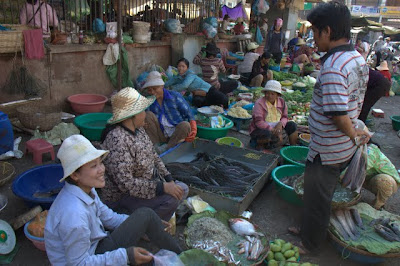
Our first priority in Battambang was signing up for that evening's cooking class at the Smokin' Pot. I learned about the class over at Lives of Wander; Theresa's right, it is one of the best deals in Asia and I'm happy to report it is still only $8 for a hands on, three dish class with a trip to the market. And unlike our trip to the market during our Thai cooking class, we actually purchased the meat and produce we'd be using in our meals.

Which means the fish swimming around in buckets became the fish for our fish amok after this lady chopped off its head.

Carrying the kaffir lime leaves and still warm chicken meat. Thank goodness our classmates voted for breast.

Like Thai cooking, Cambodian meals often start with a paste of spices and herbs ground by a morter and pestle. We used half this paste in our fish amok and the other for the spicy beef stir-fry.

Sean is turning into quite the master chef during our Asian travels. In the pan, the coconut milk, curry paste, and fish simmer for the fish amok.

When the cooking instructor said spicy beef, he meant SPICY beef. This was easily the most spicy dish we had during our six months in Asia, requiring lots of rice and water to get it down. And it only had two or three chilies, plus the ones in the paste. Our instructor told us when he makes this dish at home, each family members customizes the dish to their liking. He takes 7 chillies, his wife takes 10, and his mother in law takes a whopping 13. Spicy!

The next morning, we set off on a tour of the countryside by tuk tuk, with Philay as our guide. We didn't so much meet Philay as Philay met us, being the most patient and persistent of the horde of tuk tuk drivers that swarmed us as we got off the bus in Battambang. Tuk-tuking tourists is big business in Battambang, particularly because there are a lot more tuk tuk drivers than there are tourists, and countryside tours are the biggest score of all.

Our first stop of the morning was to a local market, where we were the only non-Cambodians in sight. You might think we would get sick of markets but you would be wrong. Asian markets never disappoint; there's always something to watch, something more colorful and outrageous than the previous market. For example, the mouse transaction above. Yes, mice.

And you can't leave without a chili chopper, at least Philay didn't think so. After passing by the live chili chopping in action, the Cambodian version of an infomercial, Philay decided his wife would really like a chili chopper too.

After the market, we stopped by a former Pepsi plant. According to our guidebook, Pepsi abandoned the plant in the 70s when the Khmer Rouge rolled in. According to Philay, the plant was still in operation until the Vietnamese took over in the 80s. Either way, it stands as it did decades ago, with glass bottles collecting dust on the inside.

When going over the day's itinerary, Philay kept asking us if we wanted to see a coke-a-die farm. A coconut farm? we said. Yes, a coke-a-die farm, he repeated. Okay, we said. We like coconuts. When we arrived, Philay paid the attendant some riel and took us over to this water pit. Oh, we both said in unison. A crocodile farm! Yes, Philay said. Like I said, a coke-a-die farm.

When the government neglected public transport for the locals, the locals came up with their own method of transport: a bamboo train. The "train" is nothing more than a slab of bamboo strips set on top of wheels, running in between the real trains. Today, I'm pretty sure it exists pretty much as a tourist trap, but we allowed ourselves to fall into the trap and off we went.
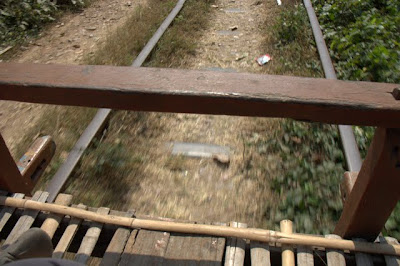
...making hurtling forward on the tracks on the unattached bamboo an interesting ride to say the least.

And oh yeah, if someone is coming in the opposite direction? One of the bamboo trains has to move. We got the boot.
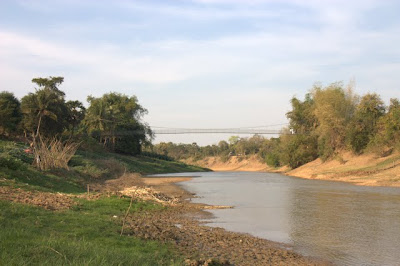
Next, we head to the riverfront, just as kids are on their way home from school and farmers finish their tasks in the late day sun.
We also do our good deed for the day; Philay stops to smoke some bats out of a tree next to a temple.

Philay seems very excited about our last stop - watching the sun set over a lotus farm - but we're a little rattled when we get there. Minutes before, on the big highway, we stopped at an accident scene that had happened right before we arrived. A man lays completely still on the side of the road. Philay learns a car ran him off his motorbike and he wasn't wearing a helmet. The lone Westerner at the scene is frantic. I can't get through to the police, he shouted, and half of this guy's head is gone! Philay agrees to drive to the police station to notify them. We start to take off when we hear sirens. Philay drives away without giving the accident a second thought. We, on the other hand, keep peppering him with questions. Cambodia has one of the highest traffic accident rates in the world; scenes like this are all too common. Unfortunately, because many people fail to wear their helmets, so are fatalities. Fines for driving without a helmet means you'll often see the male driver with a helmet, with female and child companions go without.

Philay was pleased when the lotus farm is teeming with bridal parties taking pictures. He'd been promising us weddings all day; we were never quite sure whether we were actually going to a wedding or just observing one. We're pleased we don't have to crash a wedding in our travel clothes. I pull myself together to resume my role as paparazzi. We learn Cambodian brides like big hair and big make-up on their wedding days, wear big colorful dresses that are the same color as the less ornate dresses worn by the bridesmaids, and decorate the cars in the same way Americans do.
Scenes from Angkor Wat: Day Two
After our long day exploring temples far and near on Day One, we took it easy on Day Two. We saved the two big ones for last: Angkor Wat itself (above) and Ta Prohm (think Lara Croft Tomb Raider style). Both are crowded, but you can find quiet spots for some solitude.
Angkor Wat
Ta Prohm
Scenes from Angkor Wat: Day One
The temple complex of Angkor Wat is a UNESCO World Heritage site and one of the great ruins of the world. Angkor likely was the largest preindustrial city in the world, with an elaborate system of infrastructure connecting an urban sprawl of at least 1000 square kilometres to the well-known temples at its core. It served as the seat of the Khmer Empire, which flourished from approximately the 9th to 13th centuries.
We spent two hot, sweaty days dodging persistent vendors and exploring a portion of the ruins, scrambling up and down rocks and stairs to marvel at the grandeur and intricacy of the temples. Here’s scenes from some of the temples we visited on day one:
Angkor Thom
Preah Khan (I think!)
Ta Som
Banteay Srei
Pre Rup
p.s. Happy St. Patrick’s Day!




